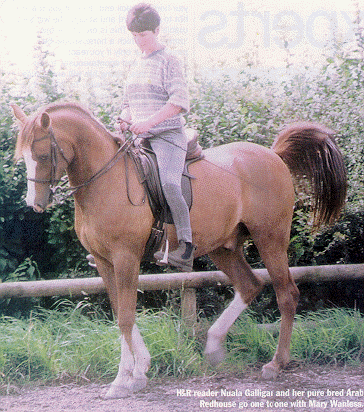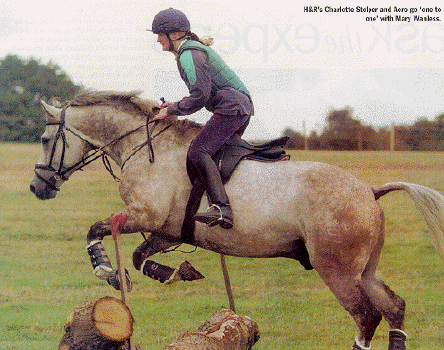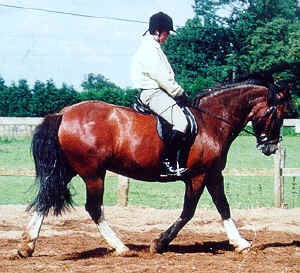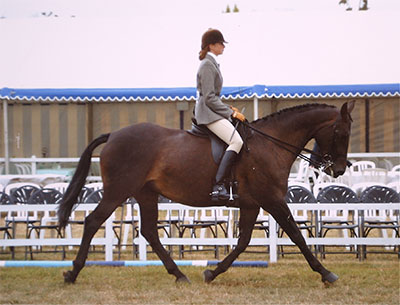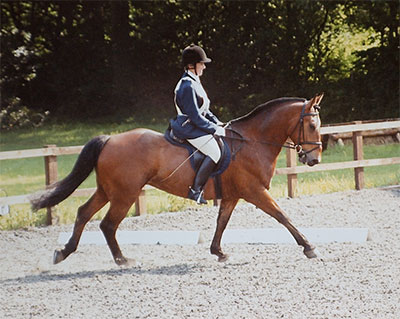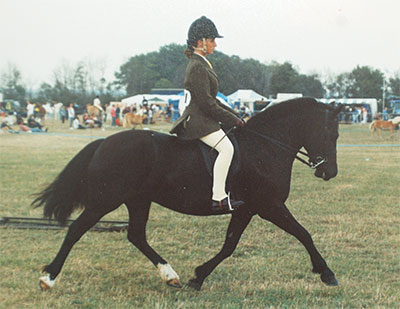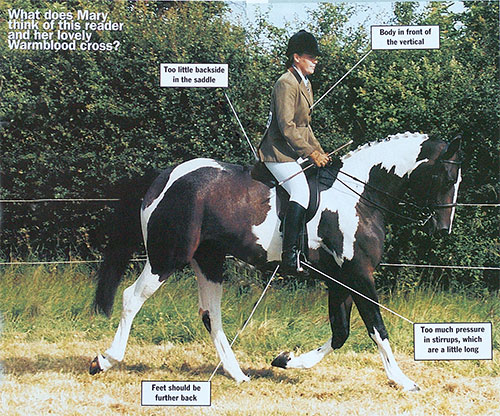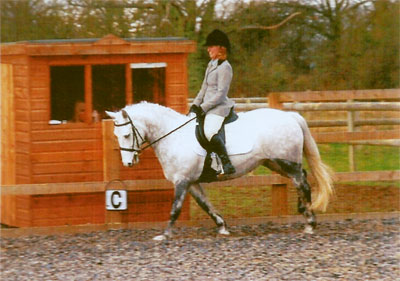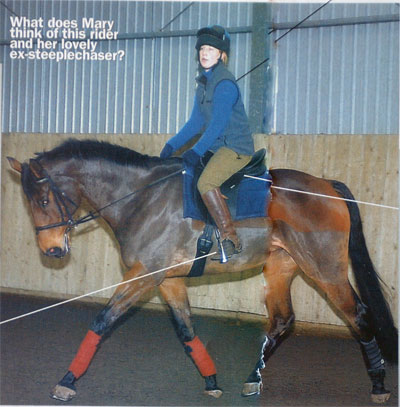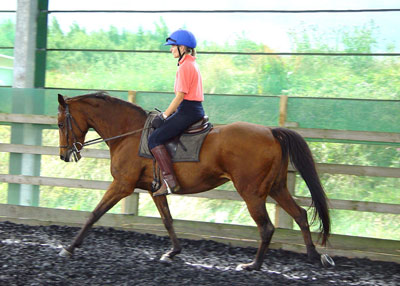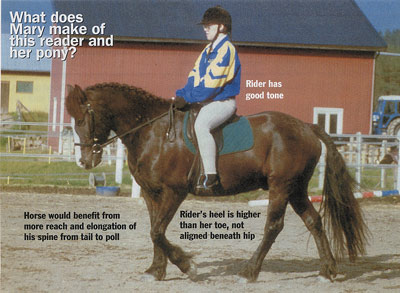RWYM
ARTICLE 8
 This nice five year old horse is being warmed up for a competition, and has been photographed in a moment of inattention. (Given the circumstances, it is likely to have been a whole session of inattention, but we can always give our rider the benefit of the doubt!) His ears are pricked, his head has come up, and he is looking off to the left.
This nice five year old horse is being warmed up for a competition, and has been photographed in a moment of inattention. (Given the circumstances, it is likely to have been a whole session of inattention, but we can always give our rider the benefit of the doubt!) His ears are pricked, his head has come up, and he is looking off to the left.
Notice how tight the angle is between his chin and the underside of his neck – it is a ‘V’ shape rather than the more open ‘U’ shape that one would like to see. He is ‘pushing back’ at the rider, as if someone had put their hand on his muzzle and pushed his muzzle back towards his poll. The knock-on effects of this push his poll back towards his neck, his neck back towards his wither, and his wither back towards his back. Inevitably, the back then hollows.
This hollow-backed posture makes life more difficult for his rider, since the horse’s movement becomes more jarring to sit on. He simultaneously becomes less manoeuvrable, and in this case, less steerable. Our rider in this photograph is coping well in a difficult situation, and although she has not been organised enough to prevent things from going wrong, neither has she been so disturbed by the wrongness that her mistakes are compounding it.
It is nice to see that she is not trying to counteract the fact that the horse has put his head up by trying to pull his head down, because that would only lead to a battle. Instead, her reaction must be to get his attention from her lower leg, kicking hard (if need be) until his ears come out sideways. It can be difficult to bring yourself to do this when you are already barely in control, but if you are bearing down and still in charge of the tempo (the speed of the step), then using your leg feels much safer. In this situation many riders would be clutching at the horse’s head and trying to slow him down, but that would only make things worse. The resulting claustrophobia could even make the horse ‘boil over’; so the answer is to ride him forward.
Our rider has to get at least a few of this horse’s brain cells orientated in her direction, and homing in on her agenda. Right now, his ears are pricked as he admires the view, and his brain is somewhere on the far side of the arena! Once she has his attention – with his ears out sideways at least some of the time – it becomes possible to influence him more, and in particular to lift his back underneath her, so that his neck lengthens and reaches away from her instead of scrunching back towards her.
There are some biomechanical changes which would enable the rider to make this change. Although her line-up is quite good, she is pushing too hard in the stirrups. Rather than thinking, ‘stretch your leg down, push your heel down’ she needs to think of making an arrowhead shape with her thigh and her calf, with her knee as the point of the arrow. The weight that is currently in the stirrup needs to be taken more in her thigh, and as her thigh becomes weight bearing it can start to act as a lever, enabling her to draw the horse’s back up under her. (I am not going to explain this in more detail here as I have done so in previous articles; suffice it to say that how the rider draws the horse’s back up under her is, for me, the nub of riding.)
Simultaneously, the rider needs to bear down, pushing her guts against her skin (as you do when you clear your throat) and thinking of pushing his neck and ears away from her. Only when she makes a push forward which is stronger than the horse’s push back will he change his carriage, relaxing the underside of his neck and taking on the posture which makes any horse look like a dressage horse.
The other big issue here is steering. You can see that as the horse’s nose has come to the left, his right shoulder has bulged to the outside (towards the camera). I do not have the impression that the rider is pulling on the inside rein, and this is just as well because if she did, she would bring his nose more to the inside and his shoulders more to the outside. This would reinforce the ‘jack-knife’ and make it worse. It is a common mistake, since riders instinctively want to turn by pulling on the inside rein and giving on the outside rein. If you did this on a bicycle you would put yourself on the floor, and the results on the horse are almost equally diabolical. Riders fare much better when they stop thinking about steering the horse’s nose, and think instead about steering his wither.
Also, many people confuse a jack-knife, in which the horse falls onto his outside shoulder, with a correct bend. But when the bend is correct, the horse’s forelegs keep stepping along the line of the circle that the rider is making, and do not fall to the outside of that line. In both cases you can see the horse’s inside eye, so this is not a sufficient guide that you are making a good turn. One of the most helpful ploys is to imagine a line drawn on the ground in the shape of the figures you want to ride. Then you endeavour to ride the horse’s forelegs along that line.
To succeed in this, our rider needs to keep the horse more ‘into her outside rein’. She has to make it impossible for him to lengthen the outside of his body so much that he can bulge onto that shoulder. Commonly, the rider colludes with the jack-knife by giving the outside hand forward, and at the same time as she does this, she gives her outside elbow forward, and her outside shoulder forward. The resulting twist of her torso to the inside can also make her lift her outside seat bone.
Although you may have heard that the rider’s shoulders should be parallel to the horse’s shoulders, and that her hips should be parallel to his hips, I think that this strategy is highly questionable. Also, few people manage to turn their shoulders without turning their hips as well – to twist your spine as suggested is not easy, and many bodyworkers (e.g. Chiropractors and Alexander Teachers) will tell you that it’s a dangerous thing to do. It is my experience that the rider is much more effective when her shoulders and hips remain on the radius of the circle she is riding.
I would suggest that this rider thinks of making a wall with her outside aids. The hand, elbow, shoulder, seat bone and thigh have to refuse to give forward, so that they do not give the horse the space he needs to bulge his shoulder outwards. At the same time, the rider has to encourage his shoulders to come to the inside. It can help to think of the horse’s inside foreleg leading the way around the turn, stepping to the left as he goes to the left. For if the horse jack-knives, it will go to the right along with his shoulders, and the left side of the horse will become ‘scrunched’.
In the photograph, the rider’s outside rein lies against the horse’s neck, as often happens when the rider has difficulty in turning. This, and other clues, make me wonder if she has her central axis over the horse’s central axis, or whether she is leaning to the inside. It is helpful to glance down from time to time and notice if your chin is directly over the horse’s mane, or if it is to the inside. Riders very rarely lean out on a circle, but they frequently lean in, and all of us are likely to do this on the rein we find harder.


